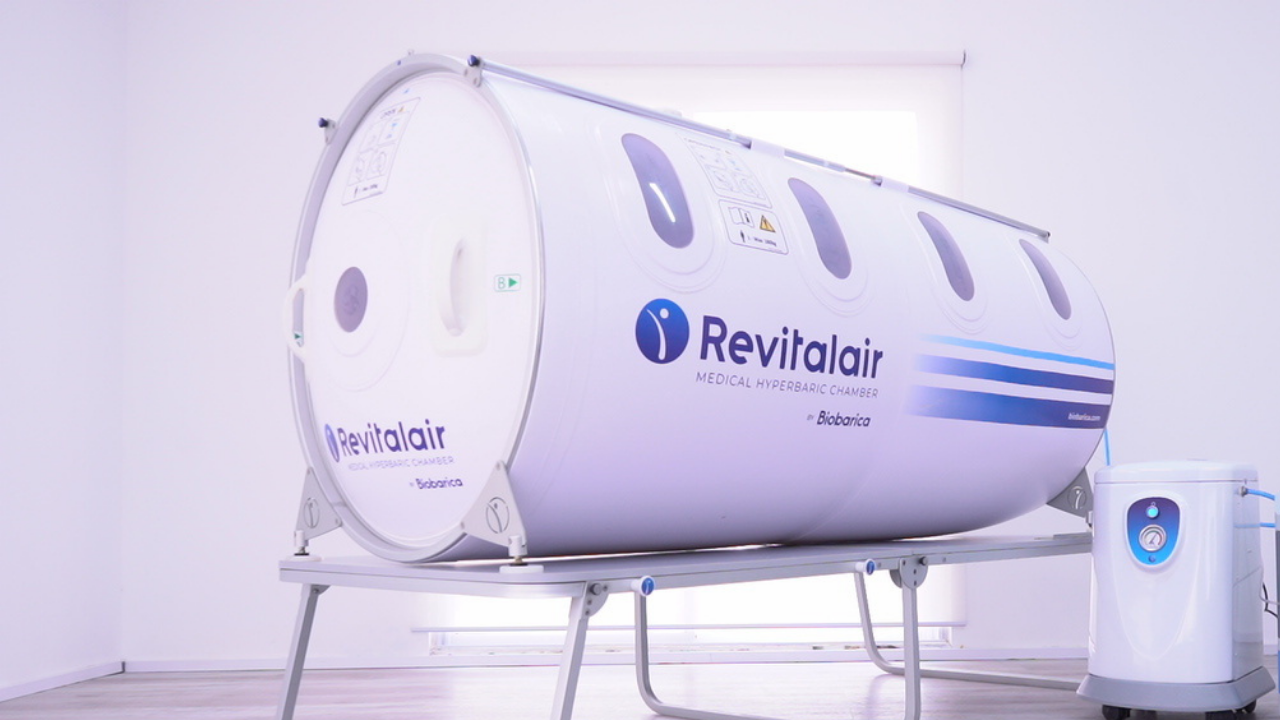October 5, 2021
5m 24s
Share:
Hyperbaric Medicine has more than 350 years of history, although its formal application is much more recent.
What is hyperbaric medicine?
It is a medical specialty that treats various pathologies in general by means of Hyperbaric Oxygenation: a therapy based on obtaining high partial pressures of oxygen inside a hyperbaric chamber, at a pressure higher than atmospheric pressure, generally with oxygen supplementation close to 100%.
How did hyperbaric medicine start?
Three and a half centuries ago, in 1662, the British clergyman Henshaw developed what is believed to be the first hyperbaric chamber, to which he gave the name "domicilium". The author of this prototypical device was confident of the possible curative effects of his invention, which could simulate atmospheric and climatic changes. "In times of good health," Henshaw himself wrote, "this 'domicilium' is proposed as a good remedy for assisting digestion, promoting insensible respiration, facilitating breathing and expulsion of sputum, and, consequently, is of excellent utility in preventing most pulmonary infections." Henshaw intuited that increased air pressure might alleviate some acute injuries, while, he felt, lower pressures might be useful in chronic pathologies. He built a hypo- and hyperbaric chamber.
Henshaw's idea was later applied in different countries in Europe to improve health with "Compressed Air Baths", as this therapy was back then called. People breathed air, not oxygen, but by increasing the air pressure, the partial pressure of oxygen goes up. This increase proved to be beneficial, but not yet understood by the physicians who applied the chamber sessions.
Unfortunately, the innovation did not produce much interest at the time, and hyperbaric oxygenation had to wait almost two centuries to advance further. Today it is known that that chamber did not modify the pressure too much, but it was the first one that existed, according to the documentation.
1832: the idea of hyperbaric chamber returns
It was not until 1832 that Emile Tabarie, in France, presented a project to the French Academy of Scientists that revived Henshaw's idea. Taberie designed a pneumatic chamber made of iron with two tubes, one providing hydraulic pressure with a compressor and the other allowing ventilation. It had an antechamber that allowed the physician to enter and exit without interrupting the pressurization.
In the same period, Lange had a cylindrical chamber built outside by iron, designed to accommodate 4 people. The temperature of the compressed air inside the chamber was kept comfortable with a cooling system in summer and the chamber was heated in winter. The pressurization system was the same system used by Tabarie.
Leibig's pneumatic chamber in Germany had 3 chambers with a capacity for 3 persons. It had an antechamber connected to the three, from which each chamber was accessed independently and a safety system improving ventilation through a tube. The temperature inside each chamber could be controlled without affecting the others.
1837: the creation of the largest hyperbaric chamber
In 1837 Pravaz built the largest hyperbaric chamber in Lyon, France, for 12 patients and treated patients with pulmonary conditions such as tuberculosis, laryngitis, tracheitis, and pertussis as well as cholera.
Around 1830 there was a renaissance of Hyperbaric Medicine in France. In 1834 Junod built a hyperbaric chamber designed by the engineer and inventor James Watt. This chamber could be taken up to 4 atm and used for lung conditions between 2 and 4 atm.
Between 1837 and 1877 in several cities in Europe (Berlin, Amsterdam, Brussels, London, Vienna, and Milan) the so-called Pneumatic Centers were opened, among which the one founded by Bertin in Montpellier and many rather luxurious pneumatic centers stood out.
First mobile hyperbaric operating room
In 1877, the French surgeon Fontaine developed the first mobile hyperbaric operating room. It was claimed that the high ambient pressure facilitated the reduction of hernias and provided relief to patients with pulmonary diseases. Over the next 3 months, 27 surgeries were successfully performed inside this mobile hyperbaric chamber. Encouraged by the results, Fontaine ventured to erect a gigantic hyperbaric surgical amphitheater to accommodate 300 patients in a single session. This did not see the light of day when Fontaine died of an accident at the Pneumatic Institute to become the first physician to be martyred in the history of hyperbaric medicine.
The first hyperbaric chamber in North America
The first hyperbaric chamber on the North American continent was built in 1860 in Oshawa, Ontario, Canada, east of Toronto. The first such chamber in the United States was built by Corning a year later in New York to treat nervous disorders.
However, the chamber that received the most publicity and was the most widely used was Cunningham's in Kansas City in the 1920s. His interest in the treatment had been motivated by the influenza pandemic that swept through the United States after World War I. Cunningham, after investigating different cases, observed that the disease was more deadly at higher elevations than in coastal areas. Already during the influenza epidemic in 1918, Dr. Cunningham placed a young resident physician who was dying of asphyxiation in a hyperbaric chamber he was using in animal experiments and saved his life by sharing it at 2 atm.
Cunningham proved to himself that his concept was true and built a chamber 26.84 meters long and 3.05 meters in diameter and started to treat different diseases, most of them without any physiological basis for those times.
His treatments lasted many hours, even all night long. On one occasion the depressurization system failed and many patients died. However, Dr. Cunninghan continued his convinced work by betting more on hyperbaric treatment.
Dr. Cunninghan treated Mr. Timkin for kidney disease in the hyperbaric chamber, curing him, and he gratefully built a chamber in 1928 of 5 stories and 19.5 m in diameter, the largest chamber that had existed up to that time. Built of steel, it had 5 floors, 12 beds on each floor with the luxury of a hotel, laboratory, living room. At that time, it was the only hyperbaric chamber operating in the world. This "ball of steel" hospital, located in Cleveland (Ohio), had inside a smoking room on the top floor, dining rooms and individual rooms and pressurized up to 3 ATA.
The American Medical Association (AMA) and the Cleveland Medical College, having no scientific justification for its treatments, forced its closure in 1930. Thus the Cuninghan-Timkin sphere or "steel ball" was dismantled during World War II to use the material after 3 years of its construction.
Although in 1670 the Irish physicist Robert Boyle observed a bubble in the vitreous humor of a snake's eye during a depressurization experiment with a small chamber (the first sign of decompression sickness in the diver), it was not until a few years later that the physical and chemical bases of Hyperbaric Medicine became known.
Development of the basics of Hyperbaric Medicine
The development of the foundations of Hyperbaric Medicine coincides with the parallel discoveries of gases, the main axis being the discovery of oxygen. This concept will be developed within this module.
At the same time that the "steel ball" hospital of Cunninghgam in Kansas, Brazil, was dismantled, Dr. Alvaro Osório de Almeida began another chapter in the history of hyperbaric medicine, when he started his research on hyperbaric oxygenation itself, using it on patients with leprosy.
In the 1950s, hyperbaric oxygen was studied by heart surgeons to increase blood oxygenation in the intervention of patients with acquired or congenital valvulopathies or to treat coronary heart disease. Dr. Barnard in Sydney was a prestigious heart surgeon who had a hyperbaric chamber built and is located in the Prince Wales Hospital.
The scientific period of Hyperbaric Medicine develops with the discoveries of Paul Bert, Haldane, and the scientific use of Dr. Boerema.
Bibliography:
- https://es.slideshare.net/ReinaldoCortezDeLaFu/oxigenoterapia-hiperbrica
- https://institutomedicinahiperbarica.es/wp-content/uploads/Historia-de-la-OHB.pdf
- http://www.bbc.co.uk/history/historic_figures/drebbel_cornelis.shtml
- Inventors and Inventions. New York. Marshall Cavendish Corporation. 2008.http://books.google.co.ve/books?id=htV7fBG_fd0C&printsec=frontcover&hl=es
- DAN.Diving.Network.Durham.2010
http://www.diversalertnetwork.org/about/history
Share:
Related
View cookie policy.


